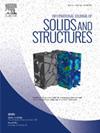Impact of interfacial degradation on flexural-torsional instability of sandwich beams
IF 3.4
3区 工程技术
Q1 MECHANICS
International Journal of Solids and Structures
Pub Date : 2025-05-04
DOI:10.1016/j.ijsolstr.2025.113427
引用次数: 0
Abstract
This paper investigates the impact of interfacial degradation and localized interfacial damage on the flexural–torsional nonlinear instability of sandwich beams. For that purpose, a nonlinear high-order sandwich beam model that incorporates the presence of imperfect interfaces that link the face sheets and the core with the potential evolution of lateral-flexural instability is developed. The research questions relate to the effect of such interfaces on the soft-core sandwich beam and its nonlinear response in the context of the lateral-torsional instability. The investigation refers to the formation of instabilities, the corresponding critical loads, the nonlinear post-buckling behavior, and their variation with the degradation of the interfaces. Along with the new modeling approach, the findings outlined in the paper include new quantitative insight into the complex nonlinear response and the role played by the ability of the interfaces to transfer tractions and maintain compatibility. The analysis reveals that the deterioration of the interfacial state affects not only the critical level of load but also the order of evolution of instabilities and particularly their nature: a stiffening post-buckling, a limit-point behavior, or a snap-through one. All depending on the interfacial properties. Together, they affect the rich deformation, traction, and stress fields in the sandwich structure and, correspondingly, the resilience of the sandwich beam.
界面退化对夹层梁弯扭失稳的影响
本文研究了界面退化和局部界面损伤对夹层梁弯扭非线性失稳的影响。为此,开发了一种非线性高阶夹层梁模型,该模型将连接面板和核心的不完美界面的存在与潜在的侧向弯曲不稳定演变结合起来。研究问题涉及到这种界面对软芯夹层梁的影响及其在侧扭失稳情况下的非线性响应。研究了失稳的形成、相应的临界载荷、非线性后屈曲行为及其随界面退化的变化规律。随着新的建模方法,本文概述的发现包括对复杂非线性响应的新的定量见解,以及界面传递牵引力和保持兼容性的能力所起的作用。分析表明,界面状态的恶化不仅会影响临界载荷水平,还会影响不稳定演化的顺序,尤其是它们的性质:屈曲后的加劲、极限点行为或断裂行为。这都取决于界面的性质。它们共同影响着夹层结构中丰富的变形场、牵引力场和应力场,相应地影响着夹层梁的回弹性。
本文章由计算机程序翻译,如有差异,请以英文原文为准。
求助全文
约1分钟内获得全文
求助全文
来源期刊
CiteScore
6.70
自引率
8.30%
发文量
405
审稿时长
70 days
期刊介绍:
The International Journal of Solids and Structures has as its objective the publication and dissemination of original research in Mechanics of Solids and Structures as a field of Applied Science and Engineering. It fosters thus the exchange of ideas among workers in different parts of the world and also among workers who emphasize different aspects of the foundations and applications of the field.
Standing as it does at the cross-roads of Materials Science, Life Sciences, Mathematics, Physics and Engineering Design, the Mechanics of Solids and Structures is experiencing considerable growth as a result of recent technological advances. The Journal, by providing an international medium of communication, is encouraging this growth and is encompassing all aspects of the field from the more classical problems of structural analysis to mechanics of solids continually interacting with other media and including fracture, flow, wave propagation, heat transfer, thermal effects in solids, optimum design methods, model analysis, structural topology and numerical techniques. Interest extends to both inorganic and organic solids and structures.

 求助内容:
求助内容: 应助结果提醒方式:
应助结果提醒方式:


